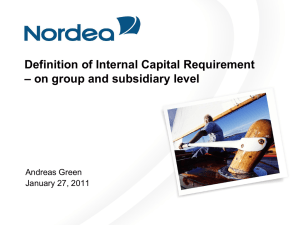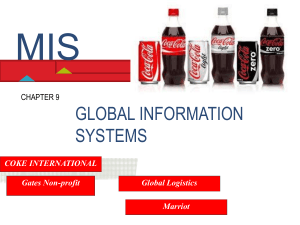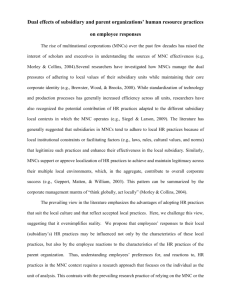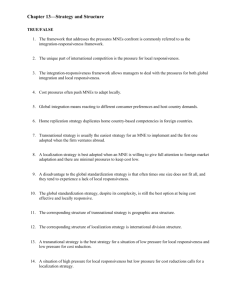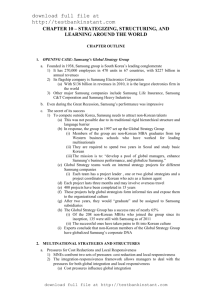Chapter 15 - Dr. George Fahmy
advertisement
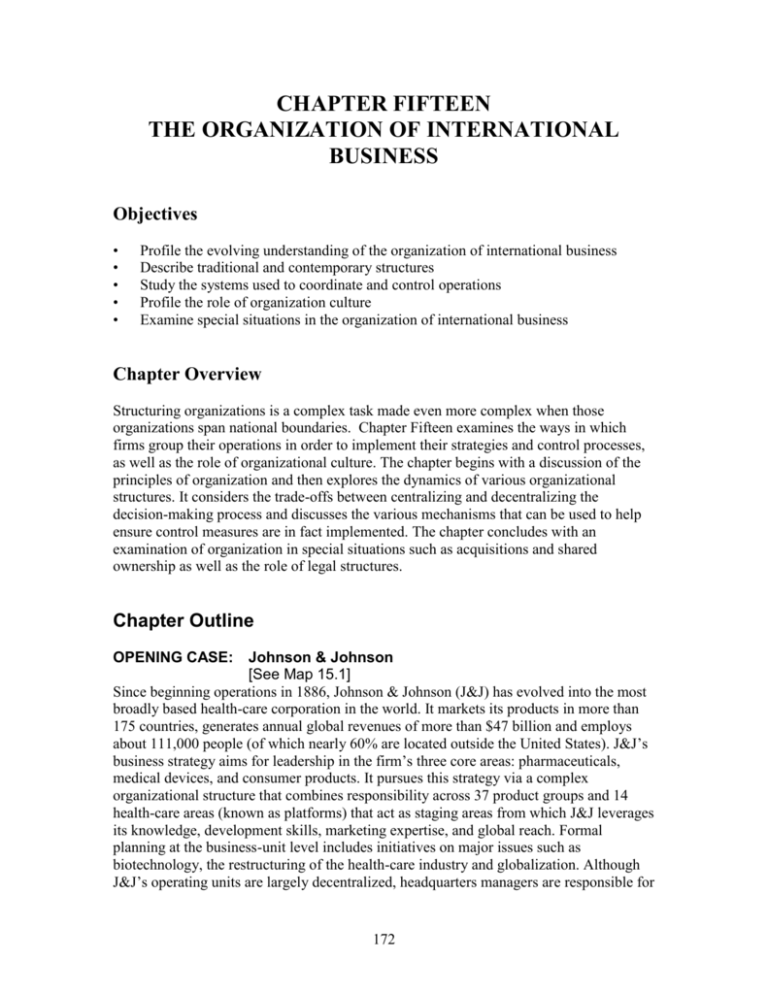
CHAPTER FIFTEEN THE ORGANIZATION OF INTERNATIONAL BUSINESS Objectives • • • • • Profile the evolving understanding of the organization of international business Describe traditional and contemporary structures Study the systems used to coordinate and control operations Profile the role of organization culture Examine special situations in the organization of international business Chapter Overview Structuring organizations is a complex task made even more complex when those organizations span national boundaries. Chapter Fifteen examines the ways in which firms group their operations in order to implement their strategies and control processes, as well as the role of organizational culture. The chapter begins with a discussion of the principles of organization and then explores the dynamics of various organizational structures. It considers the trade-offs between centralizing and decentralizing the decision-making process and discusses the various mechanisms that can be used to help ensure control measures are in fact implemented. The chapter concludes with an examination of organization in special situations such as acquisitions and shared ownership as well as the role of legal structures. Chapter Outline OPENING CASE: Johnson & Johnson [See Map 15.1] Since beginning operations in 1886, Johnson & Johnson (J&J) has evolved into the most broadly based health-care corporation in the world. It markets its products in more than 175 countries, generates annual global revenues of more than $47 billion and employs about 111,000 people (of which nearly 60% are located outside the United States). J&J’s business strategy aims for leadership in the firm’s three core areas: pharmaceuticals, medical devices, and consumer products. It pursues this strategy via a complex organizational structure that combines responsibility across 37 product groups and 14 health-care areas (known as platforms) that act as staging areas from which J&J leverages its knowledge, development skills, marketing expertise, and global reach. Formal planning at the business-unit level includes initiatives on major issues such as biotechnology, the restructuring of the health-care industry and globalization. Although J&J’s operating units are largely decentralized, headquarters managers are responsible for 172 coordinating production and marketing on a global basis and dealing with issues common to many or all operating units. Successful employees are rotated among units. Selfdirected councils (research, operations, etc.) meet regularly to swap ideas. Teaching Tip: Review the PowerPoint slides for Chapter Fifteen and select those you find most useful for enhancing your lecture and class discussion. For additional visual summaries of key chapter points, also review the figures in the text. I. INTRODUCTION Organizational challenges abound in this era of globally dispersed resources and operations. International managers must create structures, systems, and a culture that will effectively implement their company’s strategies around the world. Formulating the appropriate strategy is merely the first step of a long process that includes crafting an organization that will work to implement that strategy. Figure 15.1 summarizes the challenge of integrating different elements into a unified whole. II. THE CAUSES OF CHANGE In the past, structuring the organization was thought to be merely a matter of reorganizing the lines and boxes of the formal organizational chart. In times of rapid change, however, it is necessary to jumpstart the development of knowledgegenerating and decision-making relationships rather than to wait for them to form according to the prescribed organizational chart. Globalization has changed the opportunity set and efficiency frontier for companies (see Chapter Eleven) and has resulted in new strategies that demand more sophisticated organizations. Knowledge has become the engine of sustainable competitive advantage, requiring MNEs to build organizations that spread powerful ideas throughout their worldwide business. Finally, workplace trends in which the conduct and context of jobs are changing require that organizations change the nature of management and structure to fit the changes in the nature of work. III. ORGANIZATION IN THE INTERNATIONAL BUSINESS Companies seek to develop a complementary mix of structure, coordination and control systems, and organizational culture in order to thrive in the face of significant environmental and workplace changes. Flexibility is fostered in many organizations through the use of cross-functional task forces, dual reporting relationships, informal networking, and incentive compensation tied to group performance. IV. ORGANIZATION STRUCTURE Organizational structure is the formal arrangement of roles, responsibilities, and relationships within an organization and is a powerful tool with which to implement strategy. A company’s choice of structure depends on many factors, including the configuration of a company’s value chain in terms of the location and type of foreign facilities, as well as the impact of international operations on total corporate performance. Two central issues in organization structure are vertical and horizontal differentiation. 173 A. Vertical Differentiation: Centralization versus Decentralization Vertical differentiation refers to the issue of determining where in the company hierarchy is the authority to make what decisions. This issue becomes a decision between centralization versus decentralization of decision making authority. This relates to the discussion in Chapter 11, which illustrated the issue of balancing global integration (centralization) with local differentiation (decentralization). Centralization is the degree to which high-level managers, usually above the country level, make important decisions and pass them down to lower levels for implementation. Decentralization is the degree to which lower level managers, usually at or below the country level, make and implement important decisions (See Table 15.1). Centralized decision making is usually associated with an international or global strategy, decentralized decision making is usually associated with a multidomestic strategy, and a transnational strategy usually relies on a combination of both. B. Horizontal Differentiation: The Design of the Formal Structure Horizontal differentiation describes how the company designs its formal structure in order to (i) specify the total set of organizational tasks, (ii) divide those tasks into jobs, departments, subsidiaries, and divisions, and (iii) assign authority and reporting relationships. C. Functional Structure A functional structure groups personnel according to business function. It is ideal when products and production methods are undifferentiated across countries. However, as new and different products are added, the structure becomes cumbersome. D. Divisional Structures Divisional structures specify roles and relationships within the company in terms of outputs. Each division is assigned responsibility for a different set of products or markets. 1. International Division Structure. An international division groups all international activities into a single division within a firm. While this structure creates a critical mass of international expertise, the relationship between the international and domestic divisions is often complicated. 2. Product Division Structure. Product divisions are very popular among international companies today because most companies’ businesses involve a variety of diverse products. This structure is well suited for a global strategy and enhances a company’s ability to sell or spin off certain product lines. There will, however, likely be some duplication of activities among product divisions and knowledge transfer between divisions is minimal. 3. Geographic (Area) Division Structure. A geographic division groups activities on a regional basis and is used when a firm has extensive foreign operations that are not dominated by a single country or area. The structure is useful when maximum economies of scale and scope can be captured on a regional rather than a global basis. 174 E. Matrix Structure A matrix structure is a two-tiered structure designed to give functional, product and/or geographic groups a common focus. It is based on the theory that the groups will become interdependent and thus will more readily exchange information and resources with each other. However, the dual reporting/oversight responsibilities can also create conflicts across groups with differing objectives. F. Mixed Structure Firms seldom if ever get all of their activities to neatly correspond to a single organizational structure. Most exhibit a mixed structure, particularly with respect to foreign operations, due to legacies, executive preferences, and other circumstances. G. Contemporary Structures Many companies are moving away from traditional structures as the demands and opportunities of the international environment change. Some examples of contemporary structures include those described as learning organizations, virtual organizations, or modular structures. All of these share the same premise: A structure should not be defined by, or limited to, the horizontal, vertical, or external boundaries that block the development of knowledgegenerating and decision-making relationships in the company. Contemporary structures aim to have few to no boundaries between different vertical ranks and functions, different units in different geographical locations, and between the firm and its suppliers, distributors, joint venture partners, strategic allies, and customers. Other examples of contemporary structures include the network, virtual, and project structures. H. Network Structure A network organization is a small core organization that outsources value activities to key partners (see Figure 15.3). Many Japanese firms are linked through keiretsus, i.e., networks in which each firm owns a small percentage of the others in the network. Keiretsus may be either vertical or horizontal in nature. I. Virtual Organization A virtual organization is a temporary arrangement among partners that can be easily reassembled to adapt to market change. Operationally, the virtual organization consists of a small core of full-time employees that temporarily hires outside specialists to work on opportunities that arise. Market mechanisms such as contracts, rather than hierarchy and authority, hold the virtual organization together. J. Project Structure This type of organization has no departments or employee job titles. All work is project based, with project teams forming, disbanding, and forming again as the flow of work requires. This type of structure has proven difficult to sustain and has at times given way to a more traditional matrix organization structure. 175 POINT--COUNTERPOINT: Hierarchies or Hyperarchies? POINT: Hierarchies are a tried and true form of organization proven to be effective with complex tasks and in complex environments. Hierarchal corporate structures such as the divisional form, first developed in the 1920s by GM, DuPont, Sears, Standard Oil, and others, provide a powerful framework that allows top management to command and control operations. Certainly, the business environment is changing, but the response to these changes should not be to discard principles of hierarchy but instead to use these principles as a foundation for future success. New programs and initiatives like total quality management, scenario and contingency planning, supply chain management, and Six Sigma can be implemented to update traditional organizational forms without replacing them. COUNTERPOINT: The global business environment has changed too dramatically to be able to continue with the organizational status quo. Instead, a new form of organization known as hyperarchy is necessary to deal with the new realities. Hyperarchy is a “large-scale, self-organizing community that sets free unusually high degrees of energy and engagement—despite the lack of clear or direct economic payoff for participants.” Examples of hyperarchy include the Linux open source software project in which voluntary contributions are made by individual programmers in a totally transparent environment. Markets now reward companies that build boundaryless organizations that can survive and even thrive under the stresses brought on by rapid change. V. COORDINATION AND CONTROL SYSTEMS Systems are the framework of processes and procedures used to ensure that an organization can fulfill all tasks required to achieve its objectives. MNEs use several coordination and control tools to manage the strategic performance of their value chains. A. Coordination Systems Coordination systems link the various activities of a company to counteract the tendency of different groups of managers and employees to develop different concerns and orientations based on their location and immediate responsibilities. Managers tap several approaches to coordinate the operations of interdependent units and individuals including coordination by standardization, by plans, and by mutual adjustment. 1. Coordination by Standardization. Companies with widely dispersed operations often standardize the ways that employees do their jobs and deal with customers. Standardization sets universal rules and procedures that apply worldwide and enforces consistency in performance of activities in geographically dispersed units. Rules and regulations about how employees interact, also called formalization, aims to reduce workplace uncertainty and 176 simplify the exchange of ideas and resources. Standardization is undermined when frequent exceptions to rules are made, and is best suited for strategies that champion constancy and predictability in stable industries. Companies with an international or geocentric strategy are inclined to emphasize standardization. 2. Coordination by Plan. This type of coordination requires interdependent units to meet common deadlines and objectives. MNEs following a multidomestic strategy may opt to establish objectives and schedules that give interdependent units greater discretion in developing coordination systems. This process is often complicated by the difficulties imposed by distance and cultural differences. Greater expense, time, and possibility of error are inherent in planning across national boundaries. 3. Coordination by Mutual Adjustment. Coordination by mutual adjustment requires managers to interact with counterparts to enable flexible coordination mechanisms, largely informally. MNEs that opt to encourage mutual adjustment also adopt a formal structure and install standardization and planning systems, but they see great value in encouraging the use of informal mechanisms that create more incentive for parties to talk to one another. Mutual adjustment can be a very effective coordination tool when an MNE faces new problems that cannot be defined with customary rules or procedures. The frequent discussion and feedback needed to make mutual adjustment work, however, can be costly in terms of both time and money. B. Control Systems Every MNE must regulate what its employees can and cannot do in order to avoid spinning out of control. Control systems must ensure that people are doing what they are supposed to do and not doing what they are not supposed to do. There are three prevalent methods of control: • Market control which uses external market mechanisms to establish objective standards • Bureaucratic control which emphasizes organizational authority and relies on rules and regulations • Clan control that uses shared values and ideals to moderate employee behavior C. Control Mechanisms 1. Reports. Decisions on how to allocate capital, personnel, and technology continue without interruption, so reports must be timely, accurate and informative. Written reports are crucial for international operations because subsidiary managers so often lack substantive personal contact with corporate staff. To permit comparisons across operations, most MNEs use reports for foreign subsidiaries that resemble those they use domestically. The primary emphasis of an operations report is to evaluate a subsidiary’s performance; the evaluation of its management should generally be of secondary importance. 177 2. Visits to Subsidiaries. Within many MNEs certain members of the corporate staff spend considerable time visiting foreign subsidiaries in order to collect information and provide direction. 3. Management Performance Evaluation. MNEs should evaluate a subsidiary manager separately from the subsidiary’s performance so as not to penalize or reward managers for conditions beyond their control. That said, precisely what is within their control is frequently a matter for disagreement. 4. Cost and Accounting Comparability. Headquarters needs to use considerable discretion in interpreting the data it uses to evaluate and change subsidiary performance, especially if it is comparing a subsidiary’s performance with competitors from other countries whose currencies and accounting methods are different from its own. 5. Evaluative Measurements. A system that relies on a combination of measurements is more reliable than one that doesn’t. The most important criteria tend to be budget-compared-with-profit and budget-compared-withrevenue. Other non-financial criteria such as market share, quality control, and host government relations are also important. 6. Information Systems. With ever-expanding computer and global telecommunications links, managers can share information more quickly and easily than ever before. In fact, information technology can facilitate both the centralization and the decentralization of operations. The primary problems associated with information systems concern the cost of information relative to its value, its redundancy, and its irrelevance. VI. ORGANIZATION CULTURE Organization culture is a system of shared values about what is important and beliefs about how the world works. There is a significant link between organization culture and the financial performance of a firm and can be the most critical component of a company’s transition from “good” to “great” status. Key features of culture include values and principles of management, work climate and atmosphere, patterns of “how we do things around here”, traditions, and ethical standards. A. The Growing Importance of Culture Organization culture often shapes the strategic moves a company will consider and reject and can dramatically influence the success of corporate initiatives. Culture is increasingly important as team based approaches to management and reliance on individual-level behaviors such as learning and collaboration become more commonplace. The shared values that make up organization culture influence what employees perceive, how they interpret, and what they do to respond to their world. When confronted with opportunities or threats, organizational culture acts as a primary influence on how employees act and react. B. Challenges and Pitfalls Companies increasingly develop and manage their cultures, rather than allowing them to emerge naturally. This becomes increasingly difficult in an 178 international context, where managers from different countries often have different values than those endorsed by the company. Convergent values ease the exchange of ideas between people from different countries, while different values tend to create boundaries and barriers. To overcome these challenges, many MNEs promote closer contact among managers from different countries by rotating mangers among operations in different countries. C. Strategy and Organization Culture The type of strategy a company is pursuing both influences and is limited by the principles and practices of its organization culture (see Figure 15.4). Companies pursuing a global strategy often aim to develop a forceful culture that reinforces standardized goals, priorities, and practices. Multidomestic strategies require sensitivity to local outlooks and norms and do not lend themselves well to a strong company-wide culture. LOOKING TO THE FUTURE: The Role and Rise of Corporate Universities Corporate universities—physical and virtual institutions that lead training efforts, facilitate continuous organizational learning, and help upgrade company competencies and capabilities—have arisen as a mechanism for company’s to continually develop and monitor their organization cultures. These entities are shifting from an historical focus on teaching employees practical skills and workplace systems to instruments for inoculating all employees with the values and culture that make the organization unique. Many senior executives are leading regular courses for employees in order to facilitate greater contact with employees and to have a more direct influence on company values. Some companies are developing multiple learning sites around the world, while others prefer virtual training mechanisms over a physical structure. E-learning tactics such as live webcasts, online chat and discussion groups, videoconferences, and interactive sessions help to accomplish the objectives of the corporate university over time and space. Some see a future in which the corporate university becomes the strategic center for the company and becomes the leading force for formulating strategy and developing leadership. VII. ORGANIZATION IN SPECIAL SITUATIONS A. Acquisitions An acquired company usually does not completely mesh with the existing organization and requires changes in structures, control systems, and cultural values in order to integrate more fully with the company’s other operations. B. Shared Ownership Shared ownership usually makes control harder than it would be with wholly owned operations, but there are mechanisms that can work, such as spreading the remaining ownership among many shareholders, contract stipulations that 179 board decisions require more than a majority, dividing equity into voting and nonvoting stock, and side agreements on who will control decision making. C. Dynamic Nature of Performance As companies grow, and particularly as they expand internationally, organizational structure and control demands evolve. Companies change their structures and control systems to meet the new requirements that come with growth. VIII.THE ROLE OF LEGAL STRUCTURES When operating in a host country, companies may choose among legal forms that affect their decision-making, taxes, maintenance of secrecy and legal liability. Most choose a subsidiary form for which there are additional legal alternatives that vary by country. A. Branch and Subsidiary Organizations A foreign branch is a foreign operation not legally separate from the parent company. Branch operations are possible only if the parent holds 100 percent ownership. A foreign subsidiary, however, is a separate legal entity, established through foreign direct investment; the parent may or may not own all of the voting stock. Because a subsidiary is legally separate from its parent, legal authorities generally limit liability to the subsidiary’s assets. This concept of limited liability is a major factor in the choice of the subsidiary form. With few exceptions, claims against a firm for its actions are settled by courts either where the actions occur or where the subsidiary is legally domiciled. B. Types of Subsidiaries and Operating Form When establishing a subsidiary in a foreign country, a firm can usually choose from among a number of alternative legal forms. In addition to differences in liability, forms vary in terms of: • the ability of the parent to sell its ownership • the number of stockholders required to establish a subsidiary • the percentage of foreigners allowed to serve on a board of directors • the amount of required public disclosure • whether equity may be acquired by non-capital contributions • the types of eligible businesses • the minimum capital requirements for establishing a subsidiary. WEB CONNECTION Teaching Tip: Visit www.prenhall.com/daniels for additional information and links relating to the topics presented in Chapter Fifteen. Be sure to refer your students to the on-line study guide, as well as the Internet exercises for Chapter Fifteen. _________________________ 180 CLOSING CASE: GE Hungary [See Figure 15.5] 1. Define national and corporate cultures. How did GE’s and Tungsram’s cultures differ? How did GE attempt to use its culture as a control mechanism in Hungary and elsewhere? National culture represents the amalgam of the cultures of various distinct groups that reside within the borders of a country. If a country has only one predominant ethnic group, then national culture and ethnic culture are one and the same. Corporate culture consists of the common values shared by the employees of an organization that both serve as an implicit control mechanism and help enforce other explicit bureaucratic mechanisms. It represents the ways in which attitudes are expressed and the ways in which employees are evaluated and rewarded. GE’s corporate culture partly reflects U.S. national culture. It embodies such typical traits as individualism, self-confidence, pragmatism, optimism, universalism, low power distance, equality and a stronger orientation toward the present rather than the future. Hungarians, however, are less confident, more pessimistic, more particular about relationships than rules and more outer-directed. These national differences can largely be explained by historical experiences. GE relies heavily on culture as a control mechanism. It expects people to behave according to its cultural norms. The company feels strongly that the more it is able to “internalize” its corporate values at the subsidiary level, the more successful it will be in implementing its global strategies and policies. After a cautious start, GE proceeded to embed its corporate culture at Tungsram. Standardization of the manufacturing process for many of its products is but one reason. This change in corporate culture is partly responsible for impressive improvements in Tungsram’s productivity, quality and service. Nonetheless, GE has been accused of heavy-handedness. Its decision to transfer its corporate culture to Tungsram has been a source of such contention that it has resulted in unfavorable publicity for GE throughout the host country. 2. What were the pros and cons of changing GE’s European operations from multidomestic to regional or global? Would such a change work the same for all of GE’s product divisions? Multidomestic operations are more flexible and can more easily accommodate significant national differences among the countries where a firm is operating. The disadvantage of multidomestic operations is that decisions made on the basis of local considerations may not yield maximum benefits to the corporate organization as a whole. Regional or global operations are better able to take advantage of economies of scale and scope, facilitate the exchange of personnel and cross-country experiences and provide better organizational means of control. The disadvantage is that knowledge about local conditions might not be sufficiently factored into decisions made centrally. However, the change of strategy would not affect all of GE’s product divisions equally. While some products require minimal adaptation across countries, others require extensive changes from country to country. 181 3. What factors might account for (a) GE’s initial acquisition and subsequent expansion of light-source manufacturing and R&D in Hungary? and (b) GE’s establishing new types of businesses in Hungary? GE’s initial acquisition and subsequent expansion of its operations in Hungary were largely due to the fact that light-source manufacturing and R&D fit well with one of GE’s long-time established core businesses (lighting). In addition, Hungary is strategically located in a region that GE wished to enter. Tungsram itself was specifically attractive because of its historical presence in the East European market. Over time the firm had developed a number of important lighting source innovations, and it traditionally sold most of its production outside of Hungary. Although Tungsram’s market position eroded during the closing era of Soviet rule, GE saw an opportunity to effect a turnaround through the infusion of capital, production technology and management know-how. GE then went on to establish several new types of businesses in Hungary (banking, medical equipment, industrial equipment, electrical switches and airplane engine repair) and combined them into a new holding company, GE Hungary Inc. The purpose of the joint holding is to allow GE’s manufacturing operations to negotiate with the government of Hungary as a single voice, to centralize and standardize purchasing, accounting, human resource management, and legal representation, thereby generating significant cost savings and improving the firm’s competitive position. 4. In what ways does GE attempt to gain synergy among its operations in different countries and among its different businesses? GE has decided to position Tungsram as a lower-priced brand and to introduce its own brand as the premium quality product in Europe. The reason is that GE’s corporate logo ties together all of its activities worldwide. Corporate-wide benefits can be obtained through enlarged market shares, increased specialization, increased cross-border teamwork, the sharing of R&D, technology and other overhead costs, and because new business problems are created for competitors. While the pursuit of such benefits was surely a part of GE’s pre-investment calculations, they are difficult to quantify once realized. _________________________ CHAPTER TERMINOLOGY: organization structure, p. 526 vertical differentiation, p. 526 centralization, p. 526 decentralization, p. 526 horizontal differentiation, p. 528 network organization, p. 533 virtual organization, p. 535 hyperarchy, p. 536 coordination by mutual adjustment, p. 539 market control, p. 540 bureaucratic control, p. 540 clan control, p. 540 organization culture, p. 543 _________________________ 182 ADDITIONAL EXERCISES: The Organization of International Business Exercise 15.1. A recent trend among MNEs is to replace expatriates in foreign subsidiaries with local managers. Ask students to debate the implications of that policy from the standpoints of (a) the development and implementation of global strategies, (b) the control of foreign subsidiaries and (c) the development of managers with significant international experience and expertise. Does it mean decision-making will necessarily be decentralized? Exercise 15.2. Refer students to five recent cases: GE Hungary and Johnson & Johnson (Chapter 15), Cisco Systems (Chapter 14) and Carrefour (Chapter 13). Ask the students to compare the apparent corporate cultures of the four MNEs. Then ask them to propose and defend specific types of organizational structures for each of the firms, given the nature and extent of their operations. Would decision-making be centralized or decentralized? Exercise 15.3. Historically, many foreign firms that competed in the European marketplace established an extensive network of highly autonomous local subsidiaries. However, as Europe has evolved into a single market via the EU, those same firms have often been frustrated in their efforts to shift from a multidomestic to a regional (European) strategy. Ask students to discuss the reasons for this and to suggest mechanisms firms might use to accomplish the shift. Finally, have the students compare the strategic advantages of a long-established multidomestic-type organization to a newly established regionally oriented firm. Exercise 15.4. Ask students if they would be more comfortable working in a hierarchy or hyperarchy. Divide students into smaller groups having students of both preferences. Have the students discuss the pros and cons of each organizational mechanism and develop a list of circumstances in which hierarchy is preferable and another list of conditions in which hyperarchy is preferable. 183


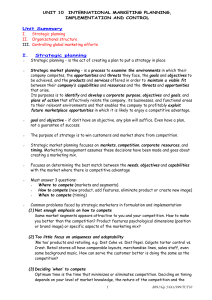
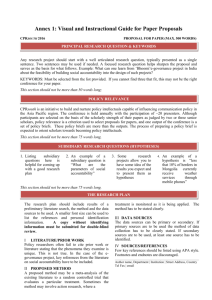
![[DOCX 51.43KB]](http://s3.studylib.net/store/data/007172908_1-9fbe7e9e1240b01879b0c095d6b49d99-300x300.png)
